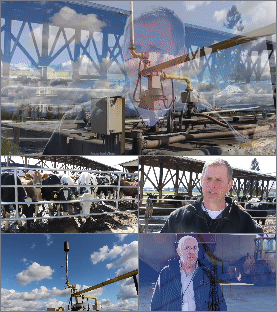US Dairy Farm Anaerobic Digestion is growing again. Anaerobic digesters are being utilised by certain US dairy farms and animal businesses to generate biogas and fertilizer from their manure.
Some even create bedding material for their stock from the fibrous digestate output.
They accomplish this by enclosing their manure holding ponds (also known as manure lagoons) to trap the biogas that accumulates in the ponds. They collect the biogas which bubbles out from the mixed liquor in these tanks.
The methane contained in the biogas may be burnt to heat water and buildings, as well as used as fuel in diesel-engine generators to create power to fuel the farm's electrical requirements.
On This Page
- Vermont dairy farmers hope anaerobic digester can provide a financial boost
- US Dairy Farms: Untapped Biogas Potential
- Generating Biogas From Dairy Waste
- Project turn cow manure and food waste into renewable natural gas sold to a nearby college
- Biogas Plant Reduces Whole-Farm Impact of Dairy Farm Waste
- Growing The Dairy Biogas-to-RNG Supply
- Dairy Agroecosystem Working Group
- Modelling greenhouse gas emissions from dairy farms
- Vanguard Renewables is a national leader in the development of organics-to-renewable energy projects.
- LEADING THE ORGANIC WASTE TO RENEWABLE ENERGY MOVEMENT
Vermont dairy farmers hope anaerobic digester can provide a financial boost
The deployment of many new biogas plants in the United States comes at a time when dairy farmers are struggling with a dilemma caused by the country's coronavirus outbreak.
Rising fuel costs, on the other hand, will give a minor cash boost to farmers who run biogas digesters while simultaneously lowering the farm's environmental impact and maybe giving lessons for other farmers interested in generating money from renewable gas.
However, dairy farms in the United States have been “brutally harmed” by covid-19 for the time being, according to Vanguard Energy, and many were already struggling prior to the introduction of covid.
Untapped Biogas Potential in US Dairy Farms
Biogas and its purified equivalent, biomethane (also known as renewable natural gas, or rng), are regarded as renewable energy sources. They also have the potential to replace more harmful legacy fuels. Over the last decade, more than 250 digester projects have been built across the United States, the great majority of which are on dairy farms.
Farms that are suitable for the manure-only programme are often larger companies that are positioned near to other farms in order to form a pod of activities. Biogas produced from dairy manure and converted to rng (renewable natural gas) has a substantial revenue potential as a result of the federal renewable fuel mandate and the California Low Carbon Fuel Standard (LCFS), which is driving the economics of these projects today.
For some years, the dairy industry in the United States has seen a long-term trend toward fewer, larger dairy farms. Some towns have spoken out against the project, citing concerns about the stench, garbage handling, and environmental degradation.
When communities witness the realities of anaerobic digestion in action, these concerns almost invariably vanish.
Anaerobic digestion is a farm waste management technology that has the potential to solve many of the problems faced by dairy farmers. It accomplishes this by, among other things, creating odour control and flammable biogas.
Generating Biogas From Dairy Waste
Digesters have been placed on dairy farms in California's central valley, generating biogas from agricultural waste rather than leaving it to degrade and emit methane into the sky.
The biogas can, and is, used to fuel farm vehicles and plants. According to a US Department of Energy study, RNG-powered cars emit up to 95% less pollution than gasoline or diesel-powered vehicles during their lifetime. Similar reductions are achieved by methane fuelled farm vehicles.
As environmental rules govern the direct application of animal manure to land. As the expense of handling farm waste rises, farmers look for more cost-effective solutions. Farmers' objectives include finding efficient and effective ways to eliminate the undesirable features of farm waste.
Projects turn cow manure and food waste into renewable natural gas sold to a nearby college
Turning cow manure and food waste into renewable natural gas provides a product that can be sold locally by large dairy farms for a profit.
That's what the Goodrich Family Farm in western Vermont is demonstrating by converting cow dung and locally produced food waste into renewable natural gas (RNG). Their methane gas will by now be being piped to neighbouring Middlebury College and to other customers willing to pay a premium for low-carbon energy.
Biogas systems have the potential to generate enough renewable energy to power 3 million households in the United States, says the developer, Vanguard Renewables.
For various reasons, renewable natural gas is approaching a tipping point: A growing number of third-party operators, such as Vanguard, are relieving farms and landfills of the responsibility of managing their own energy systems by adopting increasingly sophisticated equipment to absorb methane and pump it straight into pipes.
Some governments, notably California, are enacting legislation mandating the development of renewable natural gas.
Utilities throughout the country are also beginning to embrace these new initiatives, as shown by Dominion Energy's recent agreement with Smithfield Farms, the world's largest pig producer, to create new hog waste biogas plants.
The ultimate objective, according to supporters, is to replace a large percentage of the fossil-derived natural gas flowing through U.S. pipelines with pure methane created by human waste, animal and agricultural waste.
US Dairy Farm Anaerobic Digestion: Biogas Plant Reduces Whole-Farm Impact of Dairy Farm Waste
Agricultural waste is a big concern if it is not properly disposed of, since it may have a significant detrimental influence on the environment.
If agricultural solid wastes are carelessly dumped or burned in public locations, or even if they are dispersed directly back into the fields, they can cause:
- the generation of air pollution,
- soil contamination,
- harmful gases, known as NOx
- dust and smoke
- and the residue may be channelled into a water source thereby polluting the water and the aquatic environment.
Anaerobic digestion is one technological approach for reducing the majority of these effects while also providing a source of renewable energy.
The economic feasibility of utilising dairy-cow dung for any of the following purposes: On-farm biogas production in US Dairy Farm Anaerobic Digestion facilities and usage for power and heat generation, or biogas conversion to biomethane, a natural gas alternative.
Growing The Dairy Biogas-To-RNG Supply
The traditional oil and gas business is joining the ranks of biogas plant owners. The RNG (renewable natural gas, also known as “biomethane”) generated at selected Shell AD plants will shortly join the local natural gas network and be mixed in with the natural gas supply.
This means more work for US biogas contractors installing US Dairy Farm Anaerobic Digestion plants. Greenlane, for example, has announced the signing of contracts for the provision of two biogas upgrading systems, one for each of two different RNG dairy farm projects in the states of Wisconsin and New York created and operated by an established leader in the US waste-to-energy business.
Dairy Agroecosystem Working Group Sits
Organic waste is highly moist and heavy, making transportation costly. It makes no environmental sense to carry it across long distances since diesel-fueled transportation is non-renewable and unsustainable.
However, this has created opportunities for collaboration between farmer groups and food manufacturers in the United States. A dairy Dairy Agroecosystem Working Group has been meeting in the United States to prepare a report on this issue.
This includes small farms banding together to use a community digester and collaborating with dairy processors to recycle their wastewater in farm-based digestion rather than paying to have their waste discharged into the sewer.
Farmer-led watershed organisations provide a forum for farmers to discuss:
- best practices and
- cooperate on optimal solutions to improve overall conservation outcomes and
- reduce agriculture's ecological footprint.
Nestlé and its US-based supplier, Grande Cheese, are collaborating with the Dairy Strong Sustainability Alliance to support this initiative says the DSSA.
Decarbonization Champion Reduces Greenhouse Gas Emissions from Dairy Farms
Vanguard Renewables is dedicated to helping the world achieve net-zero carbon emissions through the following measures:
- decreases in farm-related greenhouse gas emissions and
- reductions in food waste by assisting partner farms to implement best practices for regenerative agriculture.
They are substantially reducing greenhouse gas emissions from us dairy farms, delivering new US Dairy Farm Anaerobic Digestion facilities. These are sources of clean energy to US consumers and are providing a new source of long-term revenue for family farmers across the country.
Dominion Energy is an example company that is acting as a national leader in clean energy, with the fourth-largest us solar fleet and the largest offshore wind project in the US under development along the coast of Virginia.
An increase in emissions has come as livestock farms have grown. The shift toward larger dairy cattle and swine facilities since 1990 has translated into the increasing use of liquid manure management systems, which have higher potential CH4 (methane) emissions than “dry systems,” according to the EPA’s latest greenhouse gas inventory.
Vanguard Renewables is a national leader in the development of organics-to-renewable energy projects.
Vanguard Renewables is a leader in the development and management of waste-to-energy projects for the food and dairy industries.
Vanguard is a company that constructs develops and manages farm-based US Dairy Farm Anaerobic Digestion systems that:
- trap methane from food waste and manure,
- generate clean electricity and low-carbon organic fertiliser, and
- promote regenerative agriculture by returning food nutrients to the soil.
Leading the Organic Waste to Renewable Energy Movement Across America
A new round of AD Plant construction is underway at Vanguard. They have new construction projects in which they are building farm powered anaerobic digesters in:
Colorado, Georgia, New York, and Nevada, and projects in development nationwide include those in Pennsylvania, Texas, Arizona, Wisconsin, Minnesota, Idaho, New Mexico, Kansas, and Florida,
With these numbers of current projects in progress or completed, Vanguard sat that they are leading the dairy waste to renewable energy movement across America.
The partners say that the milestones achieved underpin their commitment to providing affordable, reliable, and ever-cleaner energy to US consumers. Manure storage on dairy farms results in the release of methane, a greenhouse gas.
CalBio is another developer of US Dairy Farm Anaerobic Digestion Plants for generating renewable electricity and vehicle fuel in California It helps build digesters and methane capture projects to convert their methane output to beneficial use as RNG.
US Dairy Farm Anaerobic Digestion: US Vanderhaak Dairy Case Study
“By 1945, my grandfather had been milking around 500 milk cows. We now have around a thousand cattle in addition to all of our young stock.”
The dairy biogas plant processes the manure from those, as well as food waste for which we are compensated with a tipping charge.
The video below shows how a manure anaerobic digester helps a dairy farm remain profitable while reducing greenhouse gas emissions. The digester at Vander Haak Dairy Farm in Lynden, Washington, is shown in this film:
Traditional slurry lagoons emit an alarming amount of methane and are a major source of climate change.
Previously, dung from cows was simply dumped into a lagoon and then passed through the biogas (anaerobic digestion process) before being pumped out over the fields.
The naturally occurring microorganisms in the ancient lagoon (as on other farms without a biogas facility) turned that to methane gas. Because methane is a 25-times more potent greenhouse gas than carbon dioxide, this has a significant impact on the amount of global warming that occurs.
Make no mistake: methane emissions from slurry lagoons and dairies are significant contributors to greenhouse gas emissions. We considered constructing an anaerobic digestion facility as a way to stay in the dairy sector in this area. At the same time, we wanted to be much more sustainable in terms of both the environment and the economy.
The Simple Idea Behind All Biogas Plants
The concept behind the on-farm biogas plant is to take the natural bacteria that would naturally be present in the lagoon and place them in an engineered system: A “mechanical stomach” or digester.
The US Vanderhaak digester is a fermentation type mechanism. It has a capacity of somewhat more than a million gallons. Every day, they add around 50,000 litres of fresh manure/food waste.
They heat the material once it enters the digester. Once heated enough, it circulates through the system for 20 days. During this period, the bacteria produce methane gas, which rises to the surface and exits the digester.
The resulting raw biogas goes through a conduit into the generator building, where it is routed through the gas engine, producing power.
Electricity is delivered to the power company and then distributed via the grid. They purchase back any electricity they need to utilise on the farm.
Why Doing this is Far Less Environmentally (Greenhouse Gas Emissions) Damaging
By doing this we still make methane, but instead of the methane being released into the air we collect it. We put it through an engine. The result is that get energy out of it. The process is simply one of getting energy from the manure and food waste, while converting the more complex compounds found in organic matter, to carbon dioxide.
There is no denying that it is still a greenhouse gas but it's a greenhouse gas 25 times less powerful in producing climate change.
What Comes Out of the Digester at a US Dairy Farm Anaerobic Digestion Facility
What comes out of the biogas digester, is a combination of a liquid and a fibre.
Solid digestate is what we call that fibre, and it comes out the back end of the digester tanks as a slurry. We separate the solid, from the liquid. The mixture of dirty water and fibrous matter that comes out of the digester is piped over to a separator. From there the solids go off one side, and the liquid goes into the other. The liquid digestate is good to be applied to the fields at a later time.
The digestate fibre works very well as bedding for the cows.
The How Biogas Plant Economics Work
When building a farm anaerobic digestion plant, the capital cost is always an issue with the digester. You have to pay back that capital, and the only way you pay it back is from the revenues.
We get revenue from the power.
We get revenue from the sale of carbon credits for destroying methane.

But, one of the biggest big things that made it possible for us here in Washington, is bringing in the food waste.
It becomes economically viable with the addition of food waste and having that extra revenue from the tipping fees. Also, the extra power that the high calorific values of this type of waste provide adds significantly to profitability.
It is that extra revenue produced by the food waste which enables us to have a higher KW output, which is so useful. And, the same is true for the other digesters that are here in Washington.
In a nutshell, it's economics, and with the food waste, it's a win-win for everyone.
There's really no reason not to install a biogas plant, with the exception of looking at the economics to ensure it can be done profitably. Every farm and every milk producer is different, so they each need to look at their situation.
Conclusion to the US Dairy Farm Anaerobic Digestion US (Biogas Plant) Case Study
Often people say digesters are just not economically viable. I say yes, and no.
Yes, in the sense that for the right farms they are viable, but not for others. That's why we haven't built a whole lot of biogas plants yet, across the country (United States). But, the answer is also, no. It is no, usually, but is also possible to be a yes, because people have been entrepreneurial and found niche ways to make their biogas plants economical.
As found on Youtube
Further information on manure biogas plants is here.
[This article was first published 30 Dec 2016. Article republished and extended in October 2021.]







Greatfull content
nice thoughts helpful content